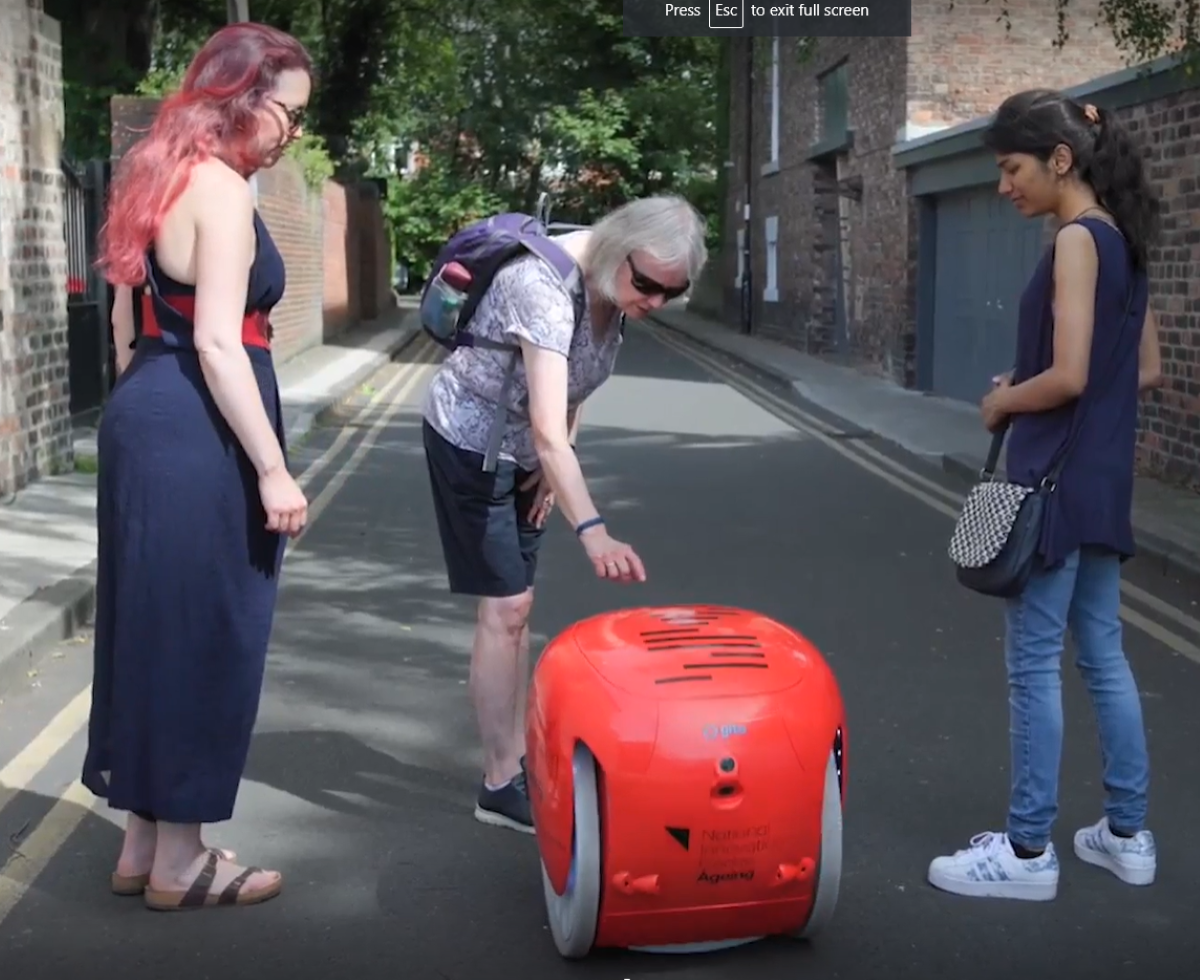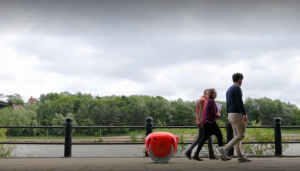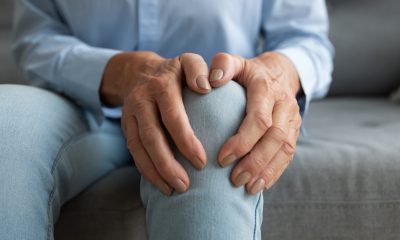Wellness
The robot companion that could soon be helping older people age better

A cargo-carrying robot that follows you around could be the answer to promoting healthy ageing.
Research carried out by Newcastle University in the UK has shown the gita robot (pronounced jee-ta and spelt with a lowercase ‘g’) can support the mobility and wellbeing of older people.
The findings of the world-first citizen-led study have revealed gita – which looks like an over-sized medicine ball on wheels and has been designed to follow humans – has the potential to help alleviate loneliness in independent older people by prompting conversations and social interaction, as well as encouraging walking, and fostering independence and more sustainable living.
Dr Shuo Li, a research associate at Newcastle University’s School of Engineering, and lead author of the study, said it “demonstrates how future mobility and robotic innovations have the potential to address the global challenge of ageing.”
Designed by Boston-based robotics company Piaggio Fast Forward and backed by the Piaggio Group – the makers of the iconic Vespa scooter – gita was launched onto the US market in 2019 to help make everyday life easier, smarter, and more fun for humans of all ages.
Its sole purpose is to follow people wherever they go. Moving at a speed of up to six miles an hour and able to carry a load of 18kg in its internal cargo compartment, gita communicates through sound, light, touch and 360-degree vision.
Whilst gita can’t climb stairs, it can move around buildings with lifts and ramps as well as hard surfaces like pavements.
With one in six of the world’s population predicted to be aged over 65 by 2050 and growing numbers of older people needing care, the team at Newcastle University spotted the potential for gita robots to help foster more independent and sustainable living, as well as potentially lessening the effects of loneliness and isolation.
The researchers showed videos of an older adult interacting with the gita robot in a real-world setting to a group of study participants with an average age of 75, and analysed their feedback and requirements.
They indicated that the robot would physically support them when out for a walk, removing the need to carry things like groceries, and even acting as a seat. Several participants also suggested the robot could be useful for carrying items to help support them whilst out for a walk.
According to the Newcastle University team the results have also shown that gita can facilitate social interactions, such as gaining potential attention and acting as a talking point to help kickstart conversations.

A gita robot being trialled in Newcastle in the UK
Other aspects the researchers investigated included the perceived benefits for others in the community, any issues of the human-following robots, and requirements for improvements.
Many of the participants suggested they did not yet need the support of a human-following robot, given that they could still carry belongings or drive, but indicated it could be useful for maintaining their mobility and independence if their health were to decline or their circumstances changed in the future.
Follow-up research is now underway to examine and quantify older adults’ interaction with a human-following robot in a real-world context.
The study has been published in the journal Nature Scientific Reports and is based on final-year research undertaken by former Master of Engineering (Meng) student, Kirsty Milligan, who was supervised by Professor Phil Blythe and Dr Shuo Li.
The civil engineering graduate said: “My research project was a valuable opportunity for me to try something a bit different as part of the final year of my MEng degree, and it was really interesting to explore whether such an innovative technology has the potential to support active ageing.
“I enjoyed talking to the participants and hearing their thoughts on the robot, as well as learning more about research methods and qualitative data analysis.
“It is really exciting that a paper based on my work has been published, and I hope it inspires others to further explore the use of these types of technologies by older people.
“I’ll be interested to see where future research in this area goes, and if maybe we will see these types of robots in everyday use one day.”
The gita robots are being tested by the team at the National Innovation Centre for Ageing (NICA) on Tyneside, a world-leading organisation supported by an initial investment from the UK government and Newcastle University, which is looking at ways of co-developing and bringing to market products and services to create an environment in which people can live better for longer.

Gita will follow behind and can carry up to 18kg of belongings
NICA’s director and one of the study’s co-authors is Professor Nic Palmarini. He said: “This is an example of how emerging technologies can help tackle and mitigate isolation and support older adults’ engagement in outdoor activities, a crucial driver to population’s health and longevity.
“This is a great example of what we have defined as ‘ageing Intelligence’ at work and is part of our wider research on supporting mobility for our older citizens.”
Phil Blythe, professor of Intelligent Transport Systems, and head of the Future Mobility Group at Newcastle University, who also co-authored the study, added: “We believe that research into supporting the mobility of older people and ensuring they have transport systems and services that are fit for purpose is critical for a fair and levelled up society.
“This is one of the key areas of my group’s research where we are always looking for future technologies that can improve the mobility of all.”
The researchers argue that while these robots offer advantages, there is a need for additional improvements to their design to fully support older people.
They say it is crucial to take into account the needs and demands of older individuals when creating and advancing age-friendly robots that can follow humans.
Limitations highlighted in the study include the possible negative interactions between the robot and others. The researchers suggest considering future iterations of the robot that address these concerns, such as implementing a security system that connects to a remote operator.
According to the study’s results, robot developers and innovators must focus on improving the robots’ ability to navigate kerbs, steps, and diverse terrain for them to be practical for most elderly people.
Research
Supplement could restore memories lost by Alzheimer’s, study finds

A naturally occurring supplement could restore memory loss in Alzheimer’s, a mouse study using human gene mutations suggests.
Nicotinamide adenine dinucleotide (NAD+) is a molecule vital for energy production, DNA repair and cellular health, often discussed by longevity specialists as a tool against age-related disease.
Researchers have discovered it can protect the brain from degeneration caused by Alzheimer’s disease.
Lead author Dr Alice Ruixue Ai, an Alzheimer’s researcher at the University of Oslo, said: “Preliminary studies have shown that supplementation with NAD+ precursors, such as (NR) or nicotinamide mononucleotide (NMN), can offer therapeutic benefits in AD [Alzheimer’s disease] animal models and early clinical trials.
“However, the molecular mechanisms behind these benefits remain largely unclear.”
NAD+ naturally declines with age, and it is believed that poor lifestyle choices — including eating a highly processed diet, smoking, drinking alcohol and getting sunburnt — can further diminish the body’s reserves.
The team engineered mice to carry the human Tau P301S mutation that causes neurodegeneration and memory loss.
These mice showed clear memory deficits in a standard behavioural test.
When they gave the mice nicotinamide mononucleotide, a compound that raises NAD+ levels, they found evidence that memory performance returned to normal.
In Alzheimer’s disease, abnormal tau — a misfolded protein that clumps in the brain — is a hallmark of the condition.
The team’s research suggests NAD+ acts through a previously unidentified RNA splicing pathway. RNA carries instructions for building proteins; RNA splicing is the natural editing step that shapes those instructions.
They first saw age-related changes in RNA splicing in a species of worm, then showed that NAD+ could correct splicing problems driven by toxic tau.
Tests in mice indicated this pathway is regulated by a protein called EVA1C, which plays a key role in RNA splicing.
When NAD+ levels rise, EVA1C helps correct splicing errors. This restoration process, involving hundreds of genes, may help reverse damage caused by tau.
Associate professor Evandro Fei Fang-Stavem, said: “Notably, we found when the EVA1C gene was knocked down, these benefits were lost, confirming that EVA1C is essential for NAD+ mediated neuroprotection.
“We propose that maintaining NAD+ levels could help preserve neuronal identity and delay cognitive decline, paving the way for combination treatments to enhance RNA splicing,” added Dr Ai.
NAD+ has gained popularity among longevity enthusiasts and celebrities.
In 2022, Hailey Bieber and Kendall Jenner discussed NAD+ IV drips in the first series of The Kardashians.
NAD+ infusion treatments are available in the UK at specialised wellness clinics.
There are also NAD+ supplements, kits and at-home injections emerging on the market.
Biohacker and longevity entrepreneur Bryan Johnson — who is 47 but claims to have the biological markers of a man in his 30s — also includes NMN supplements in his anti-ageing regimen.
News
Snoring, silence, and the menopause taboo: The hidden health crisis affecting millions

By Professor Ama Johal, clinical lead and dental sleep expert at Aerox Health
During menopause, it’s very common for women to notice significant changes to their sleep patterns and experience things like restless nights, loud snoring, or simply waking up feeling exhausted.
What most don’t realise, however, is that these symptoms can signal something far more serious – obstructive sleep apnoea (OSA), one of the most impactful and consequential sleep-related breathing disorders.
Women across the world are unknowingly fighting an uphill battle. Around 90 per cent of females with moderate to severe sleep apnoea remain undiagnosed.
This collective lack of awareness is due to a plethora of factors including archaic taboos around the subject and lack of education or omission of menopause in sexual education.
Ultimately, this combination leaves women underprepared and vulnerable to the biological, social and medical realities associated with the menopause.
Now more than ever, we must confront this silence head-on and recognise the hidden sleep crisis affecting so many women globally and the opportunity to address it.
The hidden sleep crisis
Snoring that develops or worsens during menopause can progress into OSA due to a decline in estrogen and progesterone which reduces muscle tone in the throat and in turn makes the obstruction or collapse of the airways more likely during sleep.
Yet this link between menopause and sleep disorders remains largely overlooked, leaving millions of women undiagnosed, untreated, and unaware that their sleep struggles are more than just “part of getting older”.
In my practice, I see the consequences of this misunderstanding far too often.
I hear from many female patients who have been suffering in silence, without the knowledge that they could seek help. In fact, I often encounter the common misconception that snoring is a man’s issue.
This preconceived notion perpetuates a persistent gender bias in sleep-related health research.
As ENT consultant and sleep surgeon at University College London hospitals, Ryan Chin Taw Cheong recently highlighted, the development of snoring is reason enough to consult your doctor. It’s time for this pervasive issue to emerge from the dark.
So why don’t women seek help?
When considering why many women do not seek help for their symptoms, there are two overarching reasons.
Firstly, the information and knowledge is not widely available for sufferers to realise that snoring can be a medical issue which can be assessed and subsequently readily treated.
Secondly, there is a potent stigma surrounding both the menopause and snoring which is an inhibiting factor amongst sufferers, discouraging open discussion.
Perhaps unsurprisingly, menopause is not included in traditional sex education in schools. Being unaware of what is ‘normal’ and what could require medical attention is widespread amongst my patients with sleep disorders, yet this information is not freely disseminated outside of clinics.
Unfortunately, cognitive fog and irritability – symptoms of snoring and obstructive sleep apnoea – are too often written off as stress, anxiety or ‘just the menopause’.
Avoiding sharing symptoms with medical providers, combined with online misinformation, often results in individuals suffering in silence or worse, turning to unregulated miracle menopause cures that exacerbate the risks of undiagnosed OSA.
These so-called ‘cures’ reinforce the harmful notion that the menopause is a defect which needs to be fixed rather than a natural life stage.
The health costs of ignoring snoring
A breadth of research links untreated OSA to cardiovascular disease, hypertension and cognitive decline.
However, aside from the medical risks, snoring and sleep apnoea can have profound social and emotional consequences.
For women, the shame in snoring, a symptom often mischaracterised as a ‘male issue’, can significantly affect self esteem and mental health.
Partners may also suffer if the snoring is disruptive to their sleep, in some instances causing rifts in relationships and a phenomena known as ‘sleep divorces’ (sleeping in separate beds or rooms).
In fact, according to a recent study commissioned by 32Co, 47% of recently divorced Brits cite interrupted sleep linked to snoring or sleep disorders as contributing to their relationship breakdowns, with 85 per cent believing ‘sleep divorces’ contributed to ultimate separation.
Sleep specialists seek to manage and monitor the symptoms of sleep disorders and OSA to minimise disruption to an individual’s personal and public life.
Screening menopausal women for OSA is a preventative measure which leads to informed patients. It is not simply about getting better sleep but about the long-term health outcomes.
Breaking the silence: what needs to change
Drawing on the stories of those I meet in my clinic, I would like to outline five steps that we can take to address this silent epidemic.
First, the menopause and associated symptoms should be included in a comprehensive sex and health education.
This could be provided both in schools’ curricula and made readily available at health services catering to adults.
Second, throughout the course of history women’s issues have been chronically underserved.
More resources can be funnelled into conducting research to help us better understand the impact of the menopause on women’s physical and mental health.
Future research would also help to neutralise the gender bias of previous studies.
Third, launching public health campaigns and workplace initiatives to encourage employers to recognise sleep disorders as a significant element of menopause will help build awareness and reduce the impact of stigmas.
Fourth, myth-busting, shattering taboos, and normalising discussion about the menopause will be key.
We must view snoring as a gender neutral issue rather than a male stereotype and denounce harmful rhetoric and jokes that perpetuate stigma.
Fifth, we must better equip more localised healthcare providers up and down the country to both diagnose and treat OSA effectively.
Sleep disorders are not niche issues but a major public health concern with potentially severe consequences.
Quality of life amongst my patients is inextricably linked with sleep quality.
Recognising the relationship between snoring and OSA and the menopause is not simply about pathologising a natural stage of life, but providing women with the information, respect and medical care they deserve.
Only through more transparency and collaboration amongst researchers, educators and clinicians can we hope to close the gender gap in sleep medicine and bring this hidden crisis to light.
Wellness
Diabetes expert launches ‘world-first’ music-based health learning platform

A platform that uses music to help people better understand diabetes and other healthcare concepts has been launched ahead of World Diabetes Day.
Developed by Dr Stephen Lawrence, associate clinical professor in diabetes at the University of Warwick, Prescribed Notes is the world’s first platform to use music as an immersive, memorable tool for learning complex health concepts.
Combining face-to-face and online lessons, each session is tailored, interactive and brought to life through live music and storytelling.
The platform combines live piano music with evidence-based diabetes and healthcare education to engage, inspire and empower diverse audiences.
As a practising physician, academic and accomplished improvising pianist, Dr Lawrence noticed that traditional medical education often struggles to make a lasting impact on healthcare professionals.
In response, he created Prescribed Notes, drawing on research and his own experience showing that medical information is more easily understood and retained when delivered through music and rhythmic patterns.
Dr Lawrence said: “Music has an incredible ability to make complex ideas stick in the mind.
“With Prescribed Notes, we are creating a space where medical knowledge and melody come together, helping people understand and remember healthcare concepts in a way that is both engaging and inspiring.”
“By combining storytelling, live performance and evidence-based education, we aim to transform the way people experience learning about diabetes and other health conditions, making it memorable, meaningful and, above all, enjoyable.”
Dr Lawrence brings extensive expertise to this platform, having previously served as the diabetes lead for the Royal College of General Practitioner (RCGP) and as the primary care lead for Diabetes UK.
His experience in these roles has given him insights into the challenges faced by both people living with diabetes and healthcare providers.
World Diabetes Day is an annual global awareness campaign held on 14 November to highlight the importance of diabetes awareness and management.
It marks the birthday of Sir Frederick Banting – co-discoverer of insulin.
The day serves as a platform to raise awareness about diabetes and to promote the importance of coordinated action to confront the disease as a critical global health issue.

 News2 months ago
News2 months agoSimple test can predict risk of severe liver disease

 News4 weeks ago
News4 weeks agoWeight loss drug reduces heart attack and stroke risk regardless of weight loss

 Wellness5 days ago
Wellness5 days agoDiabetes expert launches ‘world-first’ music-based health learning platform

 Research1 month ago
Research1 month agoWeight loss jabs could make cancer scans less effective, study suggests

 Research3 weeks ago
Research3 weeks agoRound up: US$25m fund to reimagine human longevity

 Wellness2 months ago
Wellness2 months agoExercise may lower dementia risk, study suggests

 Markets & Industry1 month ago
Markets & Industry1 month agoCairns buys AI health app Together by Renee

 News2 weeks ago
News2 weeks agoCitrus and grapes may protect against type 2 diabetes






































